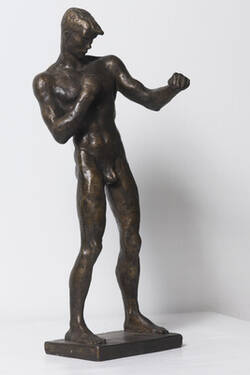The figure of "Boxer Erich Brandl" by Renée Sintenis can be found in the museum in two forms: On the first floor is the stucco figure, modelled in 1925, and here is the bronze, cast in 1960. In this way, the model and the cast can be viewed together and compared. Born in Glatz in Silesia, Sintenis worked mainly in Berlin, where she studied at the School of Arts and Crafts from 1908 to 1912. As a sculptor and graphic artist, she began by creating small sculptures of animals, including self-portraits and, in the 1920s, mainly statuettes of athletes. In 1925 she created the figure of the middleweight boxer Erich Brandl, a newcomer to boxing, which was very popular in the Weimar Republic. Sintenis shows the figure in dynamic movement, his fists clenched and always ready for battle. She modelled the well-trained body precisely, muscle by muscle. She also drew on the hype surrounding the young boxer Brandl, who had become a sex symbol of his time following nude photographs by photographer Frieda Riess.
Renée Sintenis was one of the best-known and most successful Berlin sculptors of the Weimar Republic and a colourful figure on the capital's art scene. Her expressive and dynamic figurative sculptures, including the 1920s Hair-braiding woman on the table, sold in large numbers and were highly sought-after collectors' items. In 1931, Sintenis became the first female sculptor to be admitted to the Berlin Academy of Arts, although she was forced to leave three years later as a "half-Jew" under the Nazi racial laws. However, Sintenis was able to remain a member of the Reichskulturkammer and continue to work as an artist, although her works were confiscated from public collections in 1937 as part of the 'Degenerate Art' campaign. After the war, Sintenis was one of the first women to be appointed to the Berlin Academy of Fine Arts. Her sculpture of the Berlin Bear (1957), a small gold-plated sculpture awarded at the Berlinale film festival, is still present in the capital today.
Weitere Medien
- Ort & Datierung
- 1925
- Material & Technik
- Bronze
- Abmessungen
- 40,5 x 16,5 x 16,5 cm
- Museum
- Von der Heydt Museum
- Inventarnummer
- P 0091a


